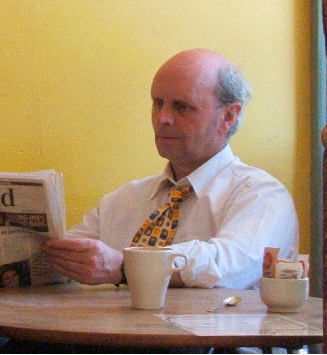David Black: COP26 – Glasgow’s misadventure?

David Black
When 12 ships from the Crimean port of Kaffa docked at Messina, Sicily, in October 1347 they carried more than onward consignments of exotic articles from the ancient oriental silk route. They also brought the bacterium versinia pestis.
This had been passed from rodents and fleas to the ships’ crews, all of whom were either dead or dying. After an initial on-board inspection the authorities ordered the ships to leave port while there were still enough sailors to heave-to, but by that time it was too late. The Black Death had entered Europe. Within five years around a third of the population would be dead. Perhaps the most poignant memorial to the great disaster today – other than the spine chilling writings of Giovanni Boccaccio, who looked on in horror as the bodies piled up in the streets – is the sad fragment of Siena’s Duomo Nova. This was meant to outstrip Rome’s St Peter’s in scale and grandeur, until, with four-fifths of the citizens wiped out, its construction was abandoned.
Then, as now, the problem with an interconnected world was that while the exchange of trade goods was an undoubted benefit both socially and commercially, the transmission of viral and bacterial infections was, from time to time, an inevitable grim consequence of the intermingling of peoples.
Over 500 years later the influenza virus ravaged the weakened populations Europe and the USA in the wake of the First World War, and arguably lit the blue touch paper for the next war when US President Woodrow Wilson was too sick to argue his ‘Fourteen Points’. These would have taken a rather more magnanimous approach to Germany than that of the French Prime Minister Clemenceau and Britain’s Lloyd George, who favoured humiliation, reparations, and revenge.
Wilson’s loyal State Department attache, William Bullitt, was so horrified that he instantly resigned, declaring “our government has consented now to deliver the suffering peoples of the world to new oppressions, subjections, dismemberments—a new century of war”.
John Maynard Keynes, as chief representative of H.M Treasury, was equally taken aback. In The Economic Consequences of the Peace, published weeks later, he predicted that the punitive reparations imposed on Germany by the Versailles Treaty would lead to a financial melt down of the country with serious economic and political repercussions for Europe and the world. He too would resign in advance of the “impending devastation of Europe”. The rest, as they say, is history.
We should bear such precedents in mind in light of the imminent 26th UN Climate Change Conference at Glasgow’s SEC. Certainly, vaccines and modern medical knowledge will mitigate the worst effects of the inevitable transmissions which will follow the arrival of more than 120 heads of states with their entourages and over 20,000 accredited delegates who are now beginning to converge on the city, some from countries in which a miniscule proportion of citizens have been vaccinated and new variants are almost certainly incubating.
In addition, an unknown number of climate extinction and other activists will be rolling into town, many of them sofa-surfing in such places as Ayr, Stirling, Falkirk and Edinburgh, given that every inch of available space will be taken up in Glasgow. It’s hardly any wonder that top scientific advisers like the Scottish government’s Linda Bauld and Devi Sridhar have expressed, albeit in measured words, a level of concern which should set alarm bells ringing. The presence of cruise ships berthed at King George V docks, it seems, are likely to make things worse.
Given that key players like Russia’s Vladimir Putin and China’s Xi Jinping will not be present, albeit coal-addicted India’s President Modi, tipped to be a no-show, will now be attending, there is no great prospect of this mighty junket initiating an agreed programme of action which will save the Earth from continuing degradation, though no doubt good intentions will be abundantly expressed.
So how, exactly, did we end up here? The idea that Boris Johnson has generously granted Scotland an opportunity to shine on the international stage is, frankly, for the birds. COP26 will be not so much a feather in the Caledonian cap as a high risk and potentially lethal global-political adventure.
One might even be tempted to ask ‘have we been suckered?’, especially in light of Sajid Javid’s latest prediction that coronavirus cases could soon be hitting 100,000 a day in England and Wales – and that comes without the bolt-ons, such as promised strikes by local refuse workers, bus drivers, and railway operatives, or the distinct possibility that violent extremists may, God forbid, be sizing up their opportunities. The words ‘perfect’ and ‘storm’ somehow spring to mind.
Has anyone attempted to model the likely negative outcomes of COP26 on Greater Glasgow and Clyde in particular (which registered a 3,291 new cases in the week prior to the writing of this article) and Scotland in general? If there is a significant spike in Covid infections, will the NHS be struggling to cope, especially in the Glasgow area, where around a third of all Scottish Covid deaths have occurred? Will the exhausted NHS staff and overworked ambulance crews get through it?
Let’s hope so. The objectives of COP26 are, without question, as honourable as they are urgent – the evidence of our eyes is finally vindicating Al Gore’s “inconvenient truth” which was, essentially, that if we don’t take action now, the world will be going to hell in a handcart. Doing nothing about greenhouse gas emissions and the continuing extraction of fossil fuels is no longer an option if we hope to save the global environment for our grandchildren, and their grandchildren. It’s called getting real.
Since every democracy has a moral and legal responsibility for the protection of its citizens the hazards of staging an international mass event on this scale in Glasgow should not be overlooked.
It would be good to think that someone, somewhere, has a plan.









